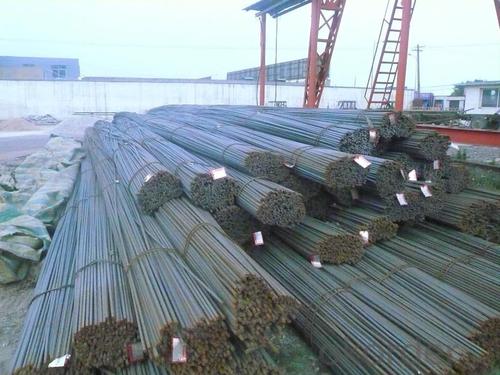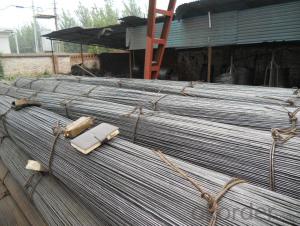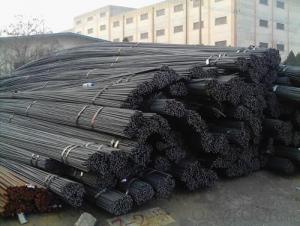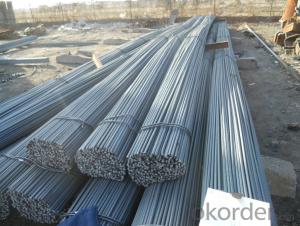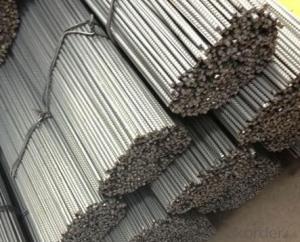steel rebar, deformed steel bar, Iron Rods For Construction
- Loading Port:
- Shanghai
- Payment Terms:
- TT OR LC
- Min Order Qty:
- 100 m.t.
- Supply Capability:
- 1000 m.t./month
OKorder Service Pledge
OKorder Financial Service
You Might Also Like
deformed steel bar grade 40
material: HRB400, BS4449 GR460B
size: 8-36mmx12m.
short delivery time by bulk or container
deformed steel bar grade 40
material: HRB400, BS4449 GR460B
size: 8-36mmx12m.
short delivery time with bulk or container
packing: Mill standard export packing in bundles/coil, around 2tons/bundle.
country of Origin: China
delivery Time: Within a 35 days
Shipment: by bulk vessel or by container
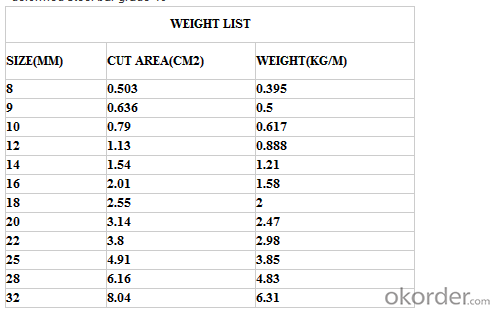
Leading goods:
section steel:angles,channels,I-beam,H-beam;
coils:cold/hot rolled coils,PPGI,galvanized coils,plate,checkered plate,cutting steel plate,steel strip;
wire rod:steel wire,deformed wire,bar;
pipe:seamless pipe,rectangular pipe,welded pipe,spiral welded pipe,pipe fittings;
stainless steel:steel sheets,stainless steel strips,stainless bar,stainless tube;
special:weathering steel,shipbuilding steel;
construction steel:C-channel,Z-channel,T-bar,high-speed divider plate,corrugated steel plate,steel grating.
Advantage:
We are the spot supplier, Six huge warehouses which can hold 20,000 MT goods.
It makes the cost lower than others,we can provide the competitive price for you.
Delivery time:
Normal sizes can be provided in 7days, the others should be ready in 30---45 days.
Further treatment:
We can offer cutting,painting,drilling holes,bending,threading, welding,galvanization,packing etc.
Security interest:
We have already passed the ISO9001, BV and SGS authentication which makes the quality secured.
If you have the interest in any of the products we can provided, pls don't hesitate to connect with me. Looking forward to cooperate with you.

FAQ of Steel Deformed Bar
1. More than 10 years experience in this industry
2. 100,000 tons exporting per month
3. Professional foreign trade tea
4. OEM&ODM capacity
5. High quality assured & competitive price
6. Try our best to meet your needs & save your budget
7. Very popular in Southeast Asia, Africa, Mid-East and South America etc.
8. VIP membership system, first time customers and long-term cooperation customers can get extra discount on some products.
- Q: What is the role of steel rebars in the construction of sports arenas and stadiums?
- The role of steel rebars in the construction of sports arenas and stadiums is to provide structural reinforcement and strength to the concrete used in the construction process. Steel rebars are embedded within the concrete to enhance its tensile strength and prevent cracking or failure under heavy loads or seismic activity. They help distribute the weight and forces evenly, ensuring the stability and durability of the structure, thereby ensuring the safety of spectators and athletes.
- Q: What are the environmental benefits of using steel rebars?
- Several environmental benefits are associated with the use of steel rebars in construction projects. Firstly, steel rebars can be reused or repurposed due to the high recyclability of steel. This reduces the need for new steel production and decreases the amount of waste sent to landfills. Furthermore, steel rebars have a longer lifespan compared to other construction materials like wood or concrete. This durability reduces the frequency of replacements and repairs, thereby decreasing the environmental impact related to the production and transportation of new materials. In addition, steel rebars provide superior strength and stability, leading to more resilient structures. This helps minimize the risk of structural failures or collapses, which can result in severe environmental consequences. By incorporating steel rebars, buildings and infrastructure gain enhanced overall safety and longevity, reducing the need for extensive future reconstruction or demolition. Moreover, steel rebars are resistant to corrosion, requiring less maintenance and upkeep over time. This reduces the use of chemicals and resources typically necessary for maintenance purposes, resulting in a lower environmental impact. Finally, steel rebars can be manufactured with a high percentage of recycled content, reducing the demand for new steel extraction and mitigating associated environmental impacts like deforestation and habitat destruction. Overall, the utilization of steel rebars in construction projects brings several environmental benefits, including the reduction of waste generation, increased durability, enhanced structural safety, lower maintenance requirements, and decreased reliance on new steel production.
- Q: How do steel rebars provide flexibility to concrete structures?
- Concrete structures can benefit from the flexibility provided by steel rebars in multiple ways. Firstly, the addition of steel rebars reinforces the concrete, enhancing its tensile strength. While concrete is strong in compression, it is weak in tension. By incorporating steel rebars, the concrete becomes more resistant to bending and cracking, as the rebars can absorb the tensile forces that would otherwise cause failure. This reinforcement enables concrete structures to withstand heavier loads and offers flexibility by preventing excessive deformation or collapse. Secondly, steel rebars can be utilized to construct a reinforced concrete frame, which boosts the overall flexibility of the structure. When embedded in the concrete, the rebars form an interconnected network of elements that distribute applied loads more evenly. This network acts as a flexible skeleton capable of adapting to various stresses, such as temperature changes, ground movements, or dynamic forces. As a result, the structure can accommodate minor movements or vibrations without sustaining significant damage. Additionally, steel rebars can be strategically positioned in areas where additional flexibility is required. For instance, in regions prone to seismic activity, rebars can be concentrated in critical areas like building joints or corners. This placement helps dissipate the energy generated during an earthquake, allowing the structure to deform and absorb seismic forces without collapsing. The flexibility provided by steel rebars enhances the seismic resistance of the concrete structure. To summarize, steel rebars contribute to the flexibility of concrete structures by increasing their tensile strength, creating a reinforced concrete frame, and allowing for strategic placement to enhance specific areas of flexibility. This flexibility enables concrete structures to withstand diverse loads, adapt to various stresses, and improve their overall strength and durability.
- Q: Can steel rebars be used in marine construction projects?
- Yes, steel rebars can be used in marine construction projects. They are commonly used to reinforce concrete structures in marine environments due to their high strength, durability, and resistance to corrosion. However, it is important to use corrosion-resistant steel rebars or apply protective coatings to prevent rusting and maintain the structural integrity of the project.
- Q: What is the yield strength of steel rebars?
- The yield strength of steel rebars typically ranges from 40,000 to 100,000 pounds per square inch (psi), depending on the grade and type of steel used.
- Q: Why is the price of screw steel affected by iron ore and coal?
- The required material is simple, "billet, iron ore with a small amount of chemical elements", and then through the hot rolling method of refining, during which a large amount of coal is needed, so the price of rebar will be affected by iron ore and coal
- Q: Are steel rebars magnetic?
- Yes, steel rebars are magnetic as they are typically made from carbon steel, which is a ferromagnetic material.
- Q: How do steel rebars help in preventing cracks in concrete structures?
- Steel rebars help in preventing cracks in concrete structures by providing reinforcement and increasing the tensile strength of the concrete. Concrete is strong in compression but weak in tension, and when subjected to external forces or changes in temperature, it tends to crack. However, by embedding steel rebars within the concrete, the tensile forces are transferred to the rebars, preventing the concrete from cracking. The rebars act as a skeleton within the concrete, distributing the tension forces evenly and preventing the formation of large cracks. This reinforcement also helps to control the size and width of any cracks that do occur, minimizing their impact on the overall structural integrity. Moreover, steel rebars help in preventing cracks by improving the ductility of the concrete. Ductility refers to the ability of a material to deform without breaking. The steel rebars provide flexibility to the concrete, allowing it to undergo small deformations without cracking. In addition, steel rebars also help in preventing cracks by reducing the effects of shrinkage and expansion. Concrete tends to shrink as it dries and expands when exposed to high temperatures. These shrinkage and expansion forces can lead to cracking, but the presence of steel rebars helps to counteract these effects by absorbing and distributing the forces. Overall, steel rebars play a crucial role in preventing cracks in concrete structures by reinforcing the concrete, increasing its tensile strength, improving its ductility, and countering the effects of shrinkage and expansion. This reinforcement ensures the structural integrity and durability of the concrete, making it more resistant to cracking and enhancing its overall performance and longevity.
- Q: What is the impact of steel rebars on the construction timeline?
- The construction timeline is greatly affected by steel rebars. These rebars are essential in reinforced concrete structures and provide strength and durability to the overall construction. It is crucial to properly install and integrate them into the concrete elements to ensure the building's structural integrity. To begin with, delays in procuring or delivering steel rebars can have a significant impact on the construction timeline. This can cause a ripple effect, postponing or slowing down construction activities that require the presence of rebars, such as formwork, concrete pouring, and curing. As a result, the overall construction timeline may be delayed. Furthermore, the installation of rebars is a meticulous and time-consuming process. Construction teams must accurately place and secure the rebars according to design specifications and engineering drawings. This involves cutting, bending, and tying rebars to create the necessary reinforced structures. Any errors or rework needed during this phase can lead to additional time being spent, potentially causing delays in subsequent construction activities. In addition, coordination between different construction trades is crucial when working with rebars. The integration of electrical and plumbing systems with rebars must be done correctly before pouring the concrete. Miscommunication or lack of coordination can result in conflicts and rework, causing delays in the construction timeline. Moreover, the quality of rebars is vital to the construction timeline. Poor quality or defective rebars can pose safety concerns and potential structural issues. In such cases, remedial actions, such as removing and replacing faulty rebars, need to be taken, leading to delays and additional costs. In conclusion, steel rebars significantly impact the construction timeline. Factors such as availability, timely delivery, accurate installation, coordination with other trades, and quality influence the overall progress of a construction project. Proper planning, communication, and monitoring are essential to effectively incorporate rebars into the construction process, minimizing potential delays, and keeping the project on schedule.
- Q: Can steel rebars be used in precast concrete applications?
- Precast concrete applications can make use of steel rebars. When referring to precast concrete, it means the process of casting concrete elements like walls, slabs, or beams in a controlled environment before transporting them to the construction site for installation. Steel rebars, which are typically made of carbon steel and have ribs on their surface to enhance adhesion to the concrete, are commonly utilized to reinforce precast concrete elements. The utilization of steel rebars in precast concrete applications comes with several advantages. Firstly, the presence of rebars increases the overall strength and durability of the precast concrete elements, enabling them to handle higher loads and reducing the risk of structural failure. Additionally, rebars enhance the resistance of precast elements to cracking and shrinkage, thereby ensuring better long-term performance. Furthermore, steel rebars facilitate the efficient transfer of tensile forces within precast concrete elements. While concrete exhibits excellent compressive strength, it is relatively weak in tension. By incorporating rebars into precast elements, the tensile forces generated during service can be effectively absorbed by the rebars, preventing cracks and maintaining the structural integrity of the element. Moreover, steel rebars offer flexibility in design and construction. Precast concrete elements can be manufactured in a wide range of shapes and sizes to meet specific project requirements, and the inclusion of rebars allows for greater design freedom. This enables the creation of complex and intricate precast elements that can be customized to suit various architectural and structural designs. In conclusion, steel rebars are crucial components in precast concrete applications. Their inclusion significantly enhances the strength, durability, and performance of precast concrete elements. By resisting tensile forces and providing structural integrity, steel rebars play a vital role in ensuring the safety and longevity of precast concrete structures.
Send your message to us
steel rebar, deformed steel bar, Iron Rods For Construction
- Loading Port:
- Shanghai
- Payment Terms:
- TT OR LC
- Min Order Qty:
- 100 m.t.
- Supply Capability:
- 1000 m.t./month
OKorder Service Pledge
OKorder Financial Service
Similar products
Hot products
Hot Searches
Related keywords



